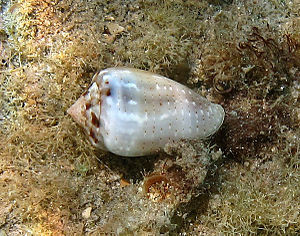Crown cone
| Crown cone | ||||||||||||
|---|---|---|---|---|---|---|---|---|---|---|---|---|

Conus coronatus , Reunion |
||||||||||||
| Systematics | ||||||||||||
|
||||||||||||
| Scientific name | ||||||||||||
| Conus coronatus | ||||||||||||
| Gmelin , 1791 |
The crown cone or the small striped ribbon mute ( Conus coronatus ) is a snail from the family of cone snails (genus Conus ), which is widespread in the Indo-Pacific . It feeds on many bristles .
features
Conus coronatus carries a small to medium-sized, moderately light to firm snail shell , which in adult snails reaches 2 to 4.7 cm in length. The circumference of the body is usually broad to broadly bellied, conical or egg-shaped, the outline weak to pronounced convex, on the left side at the base straight to concave. The case mouth is, to varying degrees, wider at the base than at the shoulder. The slightly to clearly angled shoulder is covered with tubercles. The thread is low to medium high and its outline is concave to convex. The Protoconch is multi-threaded. The whorls of the thread are often covered with strong tubercles. The seam ramps of the Teleoconch are flat to concave with 1 to 7 spiral grooves in the later whorls. Spiral strips can also run along the last seam ramp. The body is sculptured in various ways: In addition to largely smooth housings with well separated, weak spiral ribs at the base, there are housings with clear granular ribs that extend from the base to the third at the apex.
The basic color of the case is pale gray or pale beige to pink or pale purple, often with several shades that blend into one another. The periphery of the body has pale, occasionally faint spiral bands below the shoulder and center. Alternating large brown, black or olive-colored markings run spirally on both sides of the band under the middle, either separately or merging into 2 clear colored bands. Spiral rows of alternating white and dark dots or dashes at alternating intervals run from the base to the shoulder, occasionally with additional diagonal or zigzag opaque white markings. The whorls of the Protoconch are gray or light purple to red. The thread of the Teleoconch is spotted radially with alternating brown to black spots or bundles of fine lines. The case mouth is bluish to brownish-gray with pale bands below the shoulder and the middle. The thin, alternately translucent and smooth periostracum is yellow to yellowish-gray.
The color patterns of the snails themselves vary greatly depending on the region.
The radula teeth, which are connected to a poison gland , are small and strong with a barb at the tip that is faced by a long blade. They are only sawn over a short distance before the central constriction of the shaft. There is a distinct spur at the base.
distribution and habitat
Conus coronatus occurs throughout the Indo-Pacific . It lives in the intertidal zone and down to a depth of about 10 m, where it can often be found with vegetation in both protected and exposed places with fine or coarse sand between rocks or coral reefs.
Development cycle
Like all cone snails, Conus coronatus is separate sexes and the male mates with the female with his penis . The female lays her egg capsules individually or in short rows of 3 to 10 capsules on the underside of corals or limestone rocks, whereby several females together can leave behind a large clutch. The more or less rectangular capsules have a short stalk on a small basal plate and are about 4.5 mm to 12.5 mm long and 4 mm to 11 mm wide. A clutch contains about 14 to 83 egg capsules, an egg capsule about 330 to 3000 eggs and a clutch about 25,000 to 52,000 eggs. An egg is around 150 to 180 µm in size, from which it is concluded that the Veliger larvae swim freely for at least 25 to 28 days before they sink down and metamorphose into crawling snails .
food
The prey of Conus coronatus consists of Vielborstern (Polychaeta), mainly Errantia families Eunicidae , Glyceridae and Nereididae , rare Sedentaria family Capitellidae he with his Radulazähnen stands and using its Gifts from the venom gland immobilized.
literature
- Walter O. Cernohorsky: Tropical Pacific marine shells. Pacific Publications, Sydney / New York 1978. p. 133.
- Dieter Röckel, Werner Korn, Alan J. Kohn: Manual of the Living Conidae Vol. 1: Indo-Pacific Region . Verlag Christa Hemmen, Wiesbaden 1995. The texts on the individual cone snail species of the Indo-Pacific are published on The Conus Biodiversity website with the permission of the authors (see web links).
